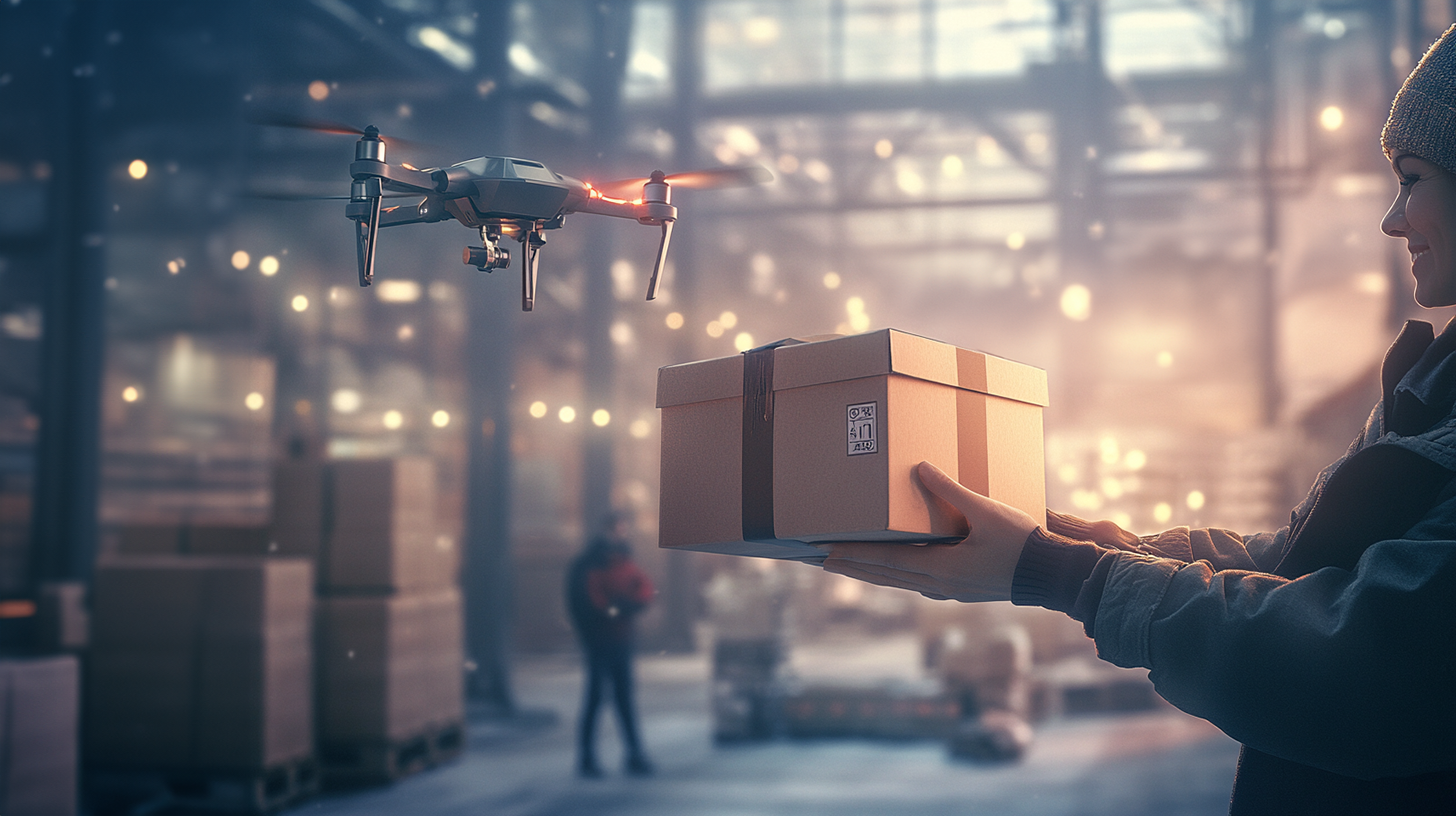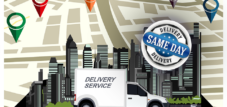Delivery time – THE logistics topic in 2014 – The trend that redefines delivery times
Language selection 📢
Published on: June 22, 2014 / Update from: November 27, 2024 - Author: Konrad Wolfenstein

Delivery time – THE logistics topic in 2014 – The trend that is redefining delivery times – Image: Xpert.Digital
Delivery speed as a guarantee of success: The strategy for satisfied customers
Today, the competition in e-commerce for customers and market share goes far beyond the pure price war, because more and more consumers value not only low prices, but also comprehensive service. The main focus here is on shipping, because for an increasingly larger group of customers, the speed at which goods ordered online arrive is a decisive criterion for their purchasing decision.
In the tough competition on the booming online market, providers have the opportunity to set themselves apart from their competitors with fast service. And this speed is not just limited to faster distribution or the immediate processing of incoming orders, but also affects the entire process efficiency in logistics: Starting with warehousing, picking and packaging, decisive time advantages can already be achieved. Shortening throughput times can now be achieved primarily by extensively automating the entire process.
Below we will look at the different starting points when it comes to delivery speed, its costs for manufacturers and customers and the challenges that the intralogistics industry has to face here.
Faster and faster – keyword same day delivery
Order meat online at lunchtime to put on the grill that same evening? Or order a sweater online at 11 a.m. that you can wear to lunch 90 minutes later? With same-day delivery, this is no longer a utopia, which is why various retailers already offer this service. The food delivery company Otto Gourmet, in collaboration with the CEP and same-day delivery specialist Time Matters, is now making it possible in the metropolises of Hamburg, Berlin, Düsseldorf, Cologne, Frankfurt and Munich to guarantee steaks after the morning order to be served “ready-to-grill” in the evening in the specified time slot. The German provider Tiramizoo, which works with Media-Saturn and Lodenfrey, among others, chooses a similar path to Time-Matters. The fashion house shipped its products during the Christmas business on a same-day basis and calculated 9.90 euros for local immediate delivery. For a comparable test run at the Thalia bookstore in Hamburg, books, DVDs, etc. cost 4.90 euros.
The British company Shutl is even one step further, allowing its customers to have their goods in their hands just 90 minutes after ordering online, with peaks of 15 minutes already being reached. The additional costs that customers have to bear average around £10. Of course, such rapid delivery required the development of a new CEP service. To achieve this, Shutl brought together a variety of courier services on a single platform and also concluded contracts with local delivery companies, such as bicycle couriers. This resulted in such a close-knit network of couriers that Shutl can always access to maintain tight delivery times. A concept that is being followed closely by the large mail order companies. A subsidiary of the Otto Group initially invested in the company before it was finally bought outright by Ebay.
Other countries are already further along. Ebay Now service over a year ago in some major US cities. If customers buy goods from retailers in their region, they will deliver the products to their home within just one hour. Amazon offers a comparable offer in the major metropolitan areas of the USA on the East (New York) and West Coast (Los Angeles and San Francisco). And Google is also experimenting in this area with its Google Shopping Express . For a period of six months, customers in the San Francisco Bay Area can order goods that will then arrive at their doorstep within one day. The difference to the other approaches is - in keeping with tried and tested Google style - that this service is initially offered free of charge.
In Great Britain, which is at the forefront of e-commerce in Europe, Shutl has been delivering goods on the same day since 2010. The cost to customers is around £10 for the delivery of a normal parcel (up to 3kg). According to Shutl, the service is already being used heavily; which means there is a willingness among buyers to pay for ultra-fast shipping.
Overall, customers in Germany, where free delivery is very important, are reluctant to agree to same-day delivery precisely because of these additional costs. The ECC study “Success Factors in E-Commerce”, supported by the logistics company Hermes, showed that only 1.6 percent of the over 10,000 customers surveyed voted for same-day delivery. In addition, almost a third of them were not prepared to pay extra for this service. An attitude that is diametrically opposed to the significant additional effort required for this shipping method; Logisticians incur significantly higher delivery costs, which they have to pass on to their customers.
Logistics companies are therefore confronted with the question of whether the area of same-day delivery remains just a niche sector for a growing but comparatively small target group. In any case, the very dense network of warehouses and transshipment centers required for such an express service can only be achieved with considerable investment. It reaches a volume that not every mail order company can handle, especially since many have recognized costs and logistics advantages in recent years, especially in centralization and concentration on a few large warehouses. It is not only for these that the question arises as to whether alternatives to same-day delivery would be more appropriate - at least in the short and medium term on the German market.
Alternatives – From 3 Days to Same Day: What customers really expect from delivery services
Speed and service have become a crucial competitive factor. And even if customers are not yet explicitly demanding same-day delivery, according to the Hermes study, two thirds of end customers expect delivery within two to three days of ordering - a short period of time that is already posing major challenges for retailers and logistics experts .
However, with the help of a high level of automation, they have managed to further reduce processing times, so that delivery to the customer has now become a critical factor for success. Anyone who is urgently waiting for a package knows the unfortunate experience of only finding a note in the evening instead of the delivery, in which the unsuccessful delivery attempt is reported along with a request to pick up the package from a warehouse or postal center.
The KEP services can provide relief here with the following solutions:
Delivery with time slots
CEP service providers are increasingly offering their customers fixed delivery windows, which enable buyers to receive parcels more conveniently. This offer also includes time-limited deliveries to alternative addresses provided in advance by the customer as well as the short-term redirection of shipments. With the help of web-based tracking solutions, customers also have the opportunity to track the status of the shipment live. In a similar model, the customer is informed via SMS or email in which time frame the package will arrive. He then has the option to reschedule the appointment once.
Particularly for working people who are not at home during the day and have no alternative drop-off options, on-time delivery represents a much higher service level than, for example, same-day delivery. In Great Britain, the service provider DPD already offers a service with a delivery window of just one hour, which has been very well received by recipients.
Delivery points
Another option is alternative delivery points, which are becoming an increasingly popular option for a growing number of consumers. These are usually kiosks, drinks shops or other shops that have extended opening hours and where customers can easily pick up their packages on the way home after work.
The pioneer in this area is the logistics company Hermes Fulfillment, which now has a nationwide parcel shop system with 14,000 stations nationwide. But competitors are also upgrading. In recent years, DPD has doubled the number of its cooperation partners to 8,000.
According to DPD, every third recipient now has their parcel deposited at a nearby parcel shop of their choice. Another study by Comscore also comes to the conclusion that 61% of customers would rather have the goods sent to a nearby parcel shop than to their own, locked front door if in doubt.
Accompanying the increasing acceptance of the parcel shop system is of course intensifying competition between CEP service providers for the ever-decreasing number of partners at attractive locations where the parcels can be dropped off and temporarily stored until the customer picks them up. But brick-and-mortar stores are far from over. Some providers are already testing the possibility of leaving the package in the customer's vehicle. A transmitter attached to the car tells the delivery person where it is parked. Using a key or a special chip card, the customer can then open the trunk and place the goods there.
Each of the alternatives described has the potential to immensely increase service levels and customer satisfaction. At the same time, they are quicker and cheaper for CEP service providers to implement than a comprehensive same-day delivery network.
But even if most European e-commerce companies are still reluctant to offer same-day delivery, the topic is apparently already present in the minds of their customers. At least the big players will therefore not be able to avoid working intensively on implementing this service into their offering.

From 2014 top topic to today: Same-Day Delivery (SDD) – How have delivery times developed compared to 2024? – Image: Xpert.Digital
Suitable for:
Impact on intralogistics
No matter how cautious the start of same-day delivery in Germany may be, according to an industry study by McKinsey & Company, it will rise to around three billion euros by 2010 in Europe and will therefore grow faster than online retail as a whole. By 2020, ultra-fast delivery is expected to account for 15 percent of total sales with standard packages.
Therefore, providers from all areas of intralogistics must not close their eyes to this trend. But how do manufacturers in the warehousing industry deal with their customers' demands for ever higher speeds in storage, retrieval and order picking?
What does the market demand?
While the large providers make investments in state-of-the-art storage and picking technologies themselves based on their financial resources, the large number of medium-sized and small online retailers have the option of purchasing the appropriate know-how in warehouse logistics from external fulfillment service providers or having their goods flows processed through them.
But whether fulfillment service providers or self-investing companies, both demand that manufacturers in the intralogistics industry take into account their need for ever shorter storage cycles and constantly accelerating order picking services.
The producers' response
Of course, intralogistics providers are increasingly adapting to the growing need for needs-based solutions for the e-commerce business. The manufacturer Kardex Remstar offers an individual part picking solution Parts4You This warehouse management software is aimed primarily at companies that need to pick small orders with small quantities from a large assortment.
It is therefore ideal for e-commerce companies. The system can be used to make around 350 picks per hour from an assortment of up to 10,000 items. Storage and retrieval processes can be carried out in parallel, which further increases the time savings during picking. The system works according to the goods-to-person principle and in this way saves travel times for personnel and machines. In addition, the savings potential in terms of the required space is considerable; the storage lift system for the paternoster cabinets, for example, has a storage area of over 1000 square meters on 84 square meters.
In addition, with its software solution Sort2Ship, an answer to the growing need of e-commerce service providers for flexible solutions for buffering and sequencing shipping orders. With Sort2Ship, the customer can bundle order items from different storage systems, such as storage lifts, carousel racks or even static racks, into one order in a time- and cost-efficient manner. The containers with the order items are transported to the buffer warehouse using automated conveyor technology, where they are temporarily stored in the smallest of spaces. On demand, the containers can then be sorted and made available for packaging or directly for loading. In particular, distribution centers or e-commerce providers with several thousand order items per day are able to use the software to increase their picking performance by up to 35% and thus ensure short delivery times.
Another way to increase the picking rates and thus the speed in the shipping warehouse is to use horizontal carousel warehouses, which transport the required items directly to the warehouse
Transport picking location. By automatically providing products to the workplace, employees can concentrate on picking and packing them, resulting in greater speed and accuracy. In addition, the warehouse employees are spared the tedious walk to the scattered goods, which at the same time leads to an enormous reduction in walking distances and thus increases ergonomics in the workplace.
📣 Similar topics
- 📦 Revolution in e-commerce: How delivery times are changing the market
- 🚀 Same Day Delivery: The new standard for express shipping?
- 💡 Innovative logistics solutions: time savings through automation
- 📋 Customer demands in focus: Why delivery speed is crucial
- 🛠️ Intralogistics of the future: Flexibility for large and small companies
- 🌍 International pioneers: What Germany can learn from the UK and the USA
- 🕒 Custom-made delivery: How delivery windows make everyday life easier
- 🛍️ Alternatives to the day delivery service: parcel shops and new delivery points
- 🔄 Fulfillment service providers: Outsourcing as a competitive advantage
- ⚙️ Technology as the key: Automated processes for faster shipping
#️⃣ Hashtags: #ECommerce #Logistics #SameDayDelivery #Customer Satisfaction #Automation
Our recommendation: 🌍 Limitless reach 🔗 Networked 🌐 Multilingual 💪 Strong sales: 💡 Authentic with strategy 🚀 Innovation meets 🧠 Intuition
At a time when a company's digital presence determines its success, the challenge is how to make this presence authentic, individual and far-reaching. Xpert.Digital offers an innovative solution that positions itself as an intersection between an industry hub, a blog and a brand ambassador. It combines the advantages of communication and sales channels in a single platform and enables publication in 18 different languages. The cooperation with partner portals and the possibility of publishing articles on Google News and a press distribution list with around 8,000 journalists and readers maximize the reach and visibility of the content. This represents an essential factor in external sales & marketing (SMarketing).
More about it here:
We are there for you - advice - planning - implementation - project management
☑️ SME support in strategy, consulting, planning and implementation
☑️ Creation or realignment of the digital strategy and digitalization
☑️ Expansion and optimization of international sales processes
☑️ Global & Digital B2B trading platforms
☑️ Pioneer Business Development
I would be happy to serve as your personal advisor.
You can contact me by filling out the contact form below or simply call me on +49 89 89 674 804 (Munich) .
I'm looking forward to our joint project.
Xpert.Digital - Konrad Wolfenstein
Xpert.Digital is a hub for industry with a focus on digitalization, mechanical engineering, logistics/intralogistics and photovoltaics.
With our 360° business development solution, we support well-known companies from new business to after sales.
Market intelligence, smarketing, marketing automation, content development, PR, mail campaigns, personalized social media and lead nurturing are part of our digital tools.
You can find out more at: www.xpert.digital - www.xpert.solar - www.xpert.plus































